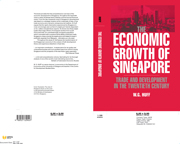Book contents
- Frontmatter
- Contents
- List of figures
- List of tables
- Preface and acknowledgements
- Abbreviations and conventions
- Geographical definitions
- Introduction
- Part One Themes and beginnings
- Part Two Development as a staple port, 1900–1939
- Part Three Staple port and rapid growth, 1947–1990
- 12 Conclusion
- Appendix tables
- Bibliography
- Index
12 - Conclusion
Published online by Cambridge University Press: 22 September 2009
- Frontmatter
- Contents
- List of figures
- List of tables
- Preface and acknowledgements
- Abbreviations and conventions
- Geographical definitions
- Introduction
- Part One Themes and beginnings
- Part Two Development as a staple port, 1900–1939
- Part Three Staple port and rapid growth, 1947–1990
- 12 Conclusion
- Appendix tables
- Bibliography
- Index
Summary
As indicated in the Introduction, the two purposes of this study have been to trace the course of Singapore's twentieth-century economic growth and, in light of it, to indicate how the experience of Singapore fits into a broader framework of development theory. The first of these objectives was addressed in earlier chapters, and many of the appropriate conclusions were drawn there. Since chapter 1 provided a summary of Singapore's growth, that will not be repeated here. This conclusion is confined to observations on the implications of Singapore's economic growth for development theory and brief comment on Singapore's future development which the vantage point of historical perspective allows.
Development economics, probably more than any branch of economics, experiences a constant tension between interpretations which emphasize the theoretically generalizable and others which favour the ‘special case’. The analysis of all less developed areas is amenable to both, but Singapore, because of its several peculiarities explored in the course of this book, is perhaps particularly open to argument for the special case.
Nevertheless, the present study made the point that for the seven decades between 1870 and 1939, Singapore was largely similar in its economic development to a number of major port cities in Asian, African and Latin American ‘vent for surplus’ regions.
- Type
- Chapter
- Information
- The Economic Growth of SingaporeTrade and Development in the Twentieth Century, pp. 361 - 371Publisher: Cambridge University PressPrint publication year: 1994

